


Liberty Theatre - 2/3 Wurlitzer, Style 135B
Oregon City, Oregon
815 Main St.
Back to the Oregon Original Theatre Installations page
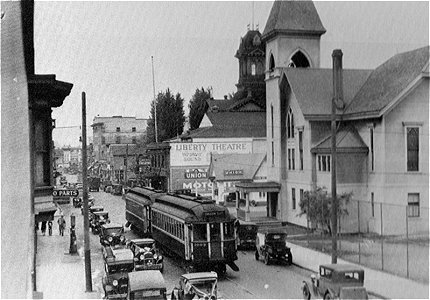
Main Street, c.1931. Photo courtesy Terry Musgrove
The Liberty Theatre had a 2/3 Wurlitzer (opus 406) installed in 1921. The "piano-style" console had an 88 note lower manual that played a piano built into the console. According to Bob Rickett, it also had a two tracker bar player that operated on vacuum taken from the intake side of the blower. It was, "...in reality, an overgrown Photoplayer."
The organ was later bought by Cleo DeAutrey and parted out. Don Ingram of Portland ended up with several of the parts which were later purchased by Steve Bray.
This news article appeared in the Oregon City Enterprise newspaper on June 25, 1921. Click for a larger version ---->
The article mentions a $15,000 Wurlitzer organ with Terry Miller as the opening night organist.
The Liberty Theatre building was demolished in March, 2004. The City plans a new "Liberty Plaza" to be completed by August, 2004. It will have a grassy area and a stage for musical events.
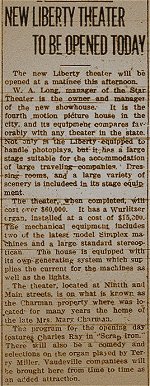
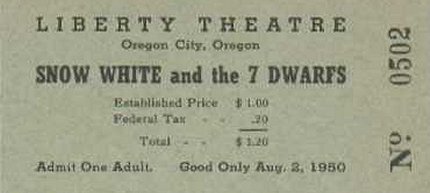
Liberty Theatre ticket, c.1950
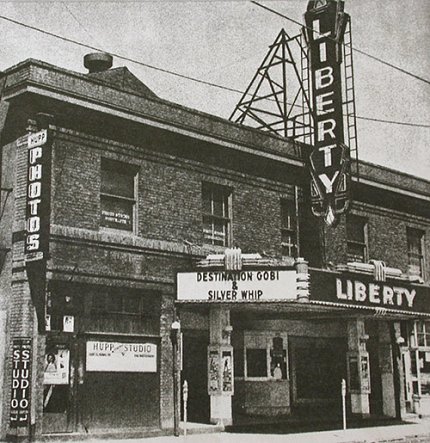
Liberty Theatre with updated signage and marquee, c.1953. Photo courtesy Terry Musgrove
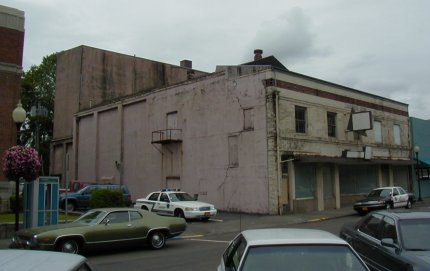
Liberty Theatre building, June 2002
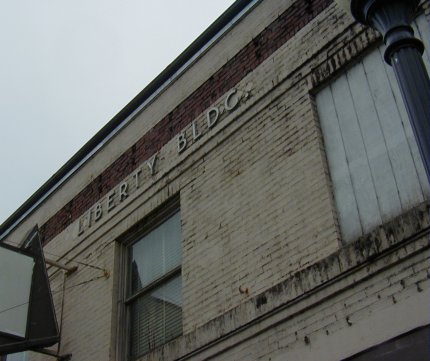
Liberty Theatre, June 2002
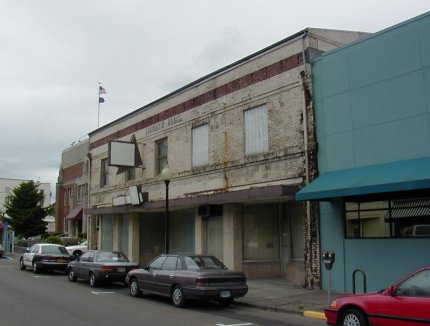
Entrance, June 2002
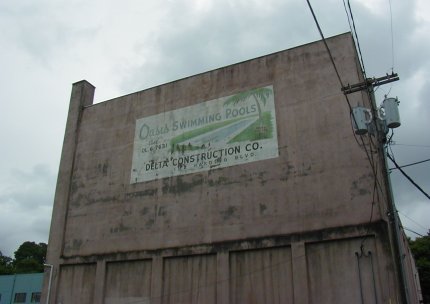
Fly loft, June 2002
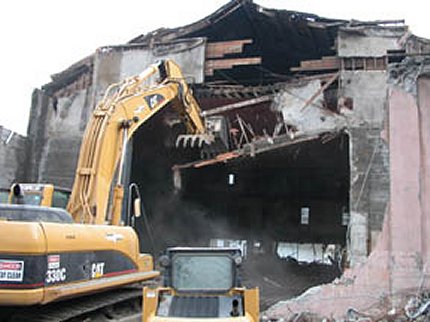
Demolition, March 2004. Clackamas Review, Patrick Sherman photo 2004.
From an article in the OREGONIAN Thursday May 30, 2002
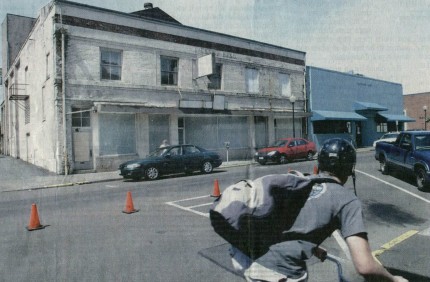
The Liberty Building In Oregon City opened as a movie house and vaudeville theater in 1921. The ground-floor storefronts were added in the early 1960's. The vacant building is in such bad shape today that the county wants to tear it down.
The county wrecking ball aims at the old Oregon City theater building
THE OREGONIAN
OREGON CITY --
Up the wobbly back staircase of the old downtown Liberty Building is a portal to the faded realm of Mae West and John Wayne, Hollywood and vaudeville.
Hidden in the airspace above a ceiling are the original balcony, walls, projection room and soaring pink ceiling of the 1921 Liberty Theatre, one of Oregon Cityís first movie houses.
The simple wall sconces that once dimmed before each show still line both sides of the theater. High rows of pegs hint at the heavy curtain of maroon velvet that draped the screen.
"You should have seen the chandelier that was in the middle of it. Oh, it was beautiful," said Clarence James, who ran the movie projector as a high school student during World War II.
But the grand old theater has been filled in, picked over and boarded up -- and the few remaining scraps will disappear soon if Clackamas County follows through with a plan to spend $450,000 to demolish it.
The building, officials say, is worn out
Daylight and rainwater pour through holes in the roof, seeping into squishy spots on the floor. Brownish mushrooms and the damp-basement smell of mildew cling to dark hallways. Bricks crumble on the facade. The city says the building is a fire hazard.
Historic preservationists are heartbroken that the building could be gone within a year, probably replaced with a vacant lot.
But it appears that nothing would prohibit the county from tearing down a building it owns, and so far no one has stepped forward with a way to retain it.
"The downtown has been systematically deconstructed over the years," said Ron Petersen of the Clackamas County Historical Society.
The Liberty Theatre opened as a movie house in 1921. It had a huge pipe organ that shook the building as it accompanied vaudeville acts on the stage up front.
"It was the nice theater in town," said James, now 75, who used to like to play the sound up loud. "It was a beautiful theater, especially when you looked down and saw all those people down below. It was usually pretty full."
Oregon City once had two other old movie theaters. The Star on Main Street, is now Dr. Johnís Pub. The State, on Seventh Street next to whatís now the main fire station, is a parking lot.
The Liberty Theatre also hosted community talent shows and fed school spirit. On days when Oregon City played West Linn in football, students would form a line and "snake dance" down the hill and through the Liberty, remembers Patty Carlson, who went to Oregon City High School in the 1950s. Students would snake down one aisle, cross the stage and go up the other aisle before winding their way to Kelly Field for the game.
The Liberty closed in 1960. Itís unclear why. The sloping theater floor was filled in, and a low, false ceiling was installed, hiding the balcony.
A storefront facade was built, replacing a deep overhang where people could get out of the rain while waiting to buy tickets. The building became the 88 Cent Store, which sold everything from sweater socks to Old Spice.
Clackamas County bought the building from a relative of the original theater owner for $110,000 in 1990. Sandwiched between county buildings, it was considered a possible site for county expansion. At that time, the building was in good enough shape that an office tenant rented part of the ground floor, and the county used the rest of it to store records.
The county didnít have much money to fix the leaking roof and other problems, and the building deteriorated until the air quality was so bad that the office tenants had to move out. Then it got too wet to store records anymore, and the county stopped using it.
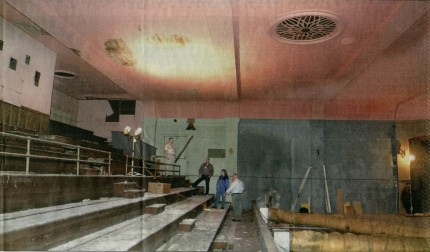
The projection room (upper left), balcony, walls and ceiling of the Liberty Theatre are still intact inside the crumbling building next to the Clackamas County Courthouse on Main Street in Oregon City. A chandelier once hung from the rosette in the ceiling.
"Demolition by neglect"
Oregon City architect Todd Iselin, who designed the renovations to the main Oregon City fire station, said the building became victim of "demolition by neglect."
Most of the theater is gone or ruined. There are no seats left, and only one of the house lights still has its colorful, bowl-shaped glass shade. Waterlogged chunks of plaster have fallen from the ceiling. There is no movie screen and no projector -- only a few bent film reels behind the projection booth.
County workers stash things in there that no one can use but that no one is ready to throw away: worn desks and chairs, old light fixtures from the courthouse next door, a stainless-steel medical examinerís table and a strap-and-pulley contraption used to lift corpses before Clackamas County autopsies started going to Portland.
Ron Pacholl, construction manager for the county, said the building needs to be demolished because it is dangerous. The last time a county worker went on the roof, he fell through it. A piece of the roof once blew off and hit someone in the face.
"It's worth more as vacant space," Pacholl said.
Tom Busch, who runs the furniture store across the street from the theater, said the building is a dangerous eyesore that detracts from downtown businesses. Heíd like to see it fixed up or torn down, but not left to fall apart.
Mayor John Williams is convinced that no private developer would want to take on the cost of renovating a building in such horrible shape. "It isnít worth the powder to blow it up," he said.
Others think the right combination of financial help and political will could motivate a private developer to preserve the building.
"I think it can be brought back and made to be a viable building ... for not a whole lot more than theyíre looking at spending to demolish it," said Iselin, a former chairman of Clackamas County Historic Review Board.
Astoria theater rehabilitated
In Astoria, an old movie theater in worse shape than the Liberty recently was rehabilitated, mostly because of grass-roots movement to save the building said Stephen Poyser, preservation planner for the state Historic Preservation Office. The Astoria theater also was called the Liberty.
State historic preservation statutes require counties to preserve buildings of historic significance and not to let them fall into disrepair. The city designated the building a historic landmark in the 1990s, but now city officials are trying to figure out whether the designation is valid because there might have been some procedural problems. The county has opposed the historical designation.
Even if the designation is valid, the city would have the power only to delay demolition to allow time for public involvement.
Denyse McGriff, an Oregon City resident and member of the Clackamas County Historic Review Board, said board members have been trying to discuss the building with city officials but werenít told about the demolition proposal. Demolition funding is in the 2002-03 county budget, which comes up for a final vote in June.
"You tear down a building. and you put in a parking lot -- I sound like a Joni Mitchell song" McGriff said. "Itís like a fabric.... We know that downtown still has a way to go, but still, the fabric is there. The fabric can be further strengthened."
LIBERTY BUILDING
Clackamas County has tentatively budgeted money to demolish the Liberty Theatre building. 813 Main St. in Oregon City, in the 2002-03 fiscal year. The building has gone through several uses during the years, among them:
| About this site | © PSTOS, 1998-2004 |